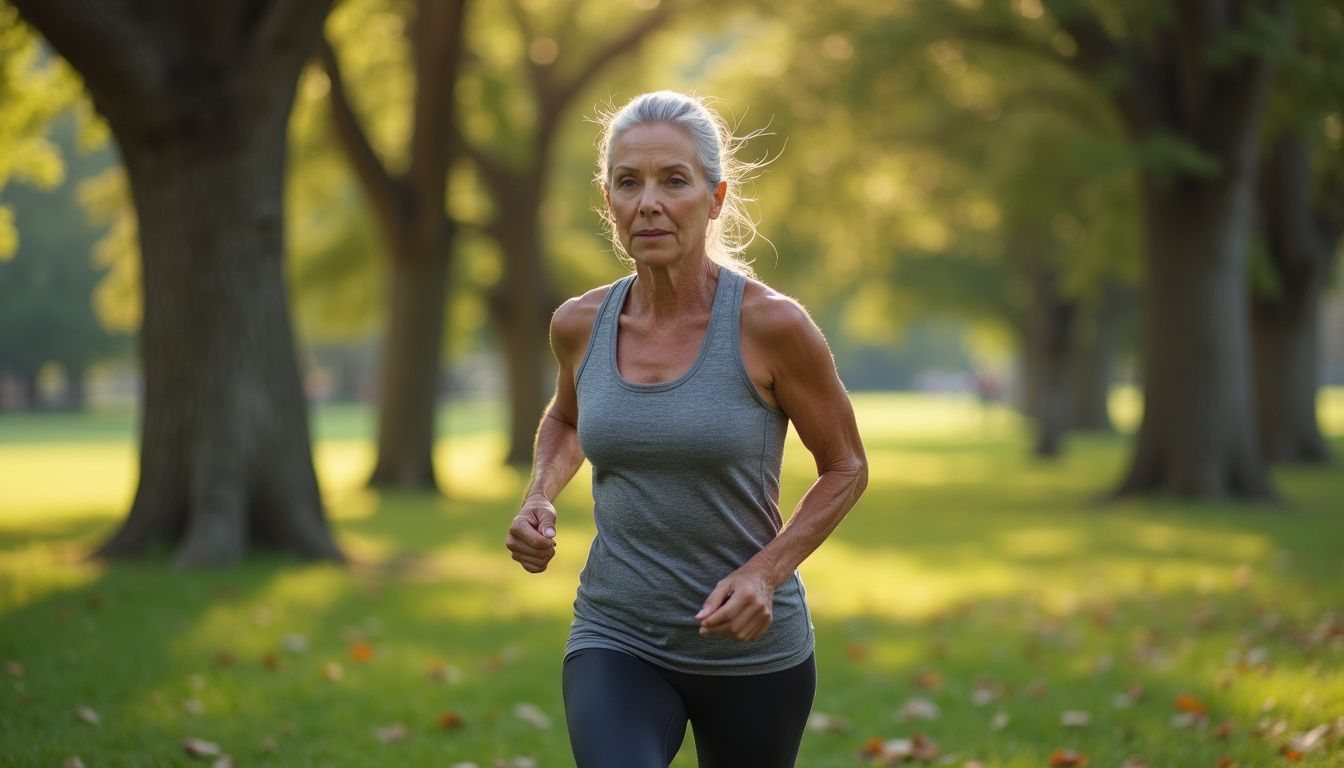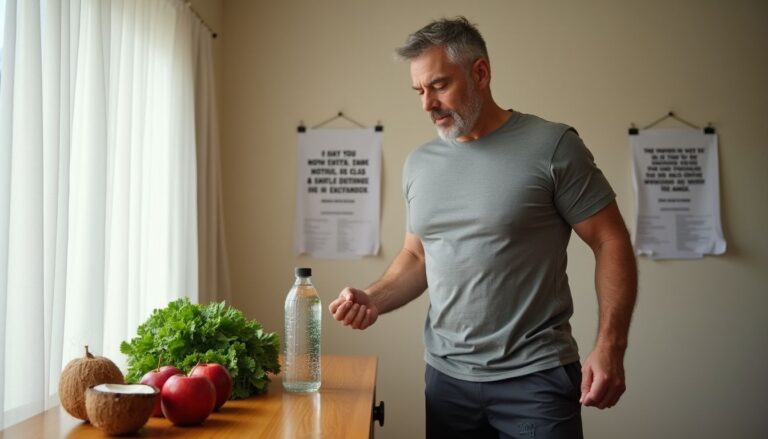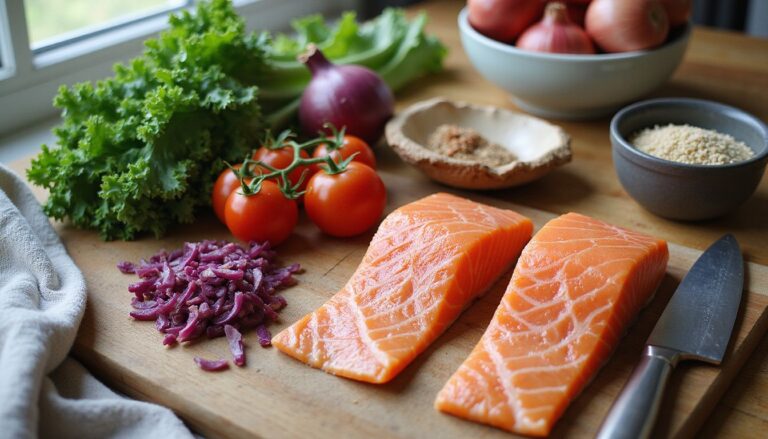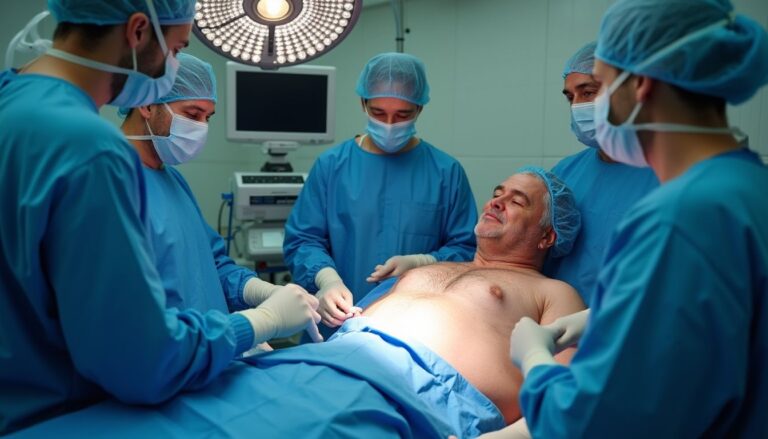Losing Weight After 50: Menopause And Women Over 50 Weight Loss Tips
Our Nutrition Assistant AI Suite will transform your body. You will lose fat, get toned, and build muscle. Gain confidence and optimal health.
Losing weight after 50 can feel harder as your body changes with age. Menopause can add to that challenge, and many women notice extra pounds gathering around the belly.
In this guide, you will learn simple nutrition, exercise, and lifestyle steps that fit the needs of women over 50. These strategies help you manage weight, protect health, and feel more in control each day.
Keep reading for clear, practical ways to start a healthy change.
Key Takeaways
- Metabolism slows with age. After 60, it drops about 0.7 percent each year. Most women over 50 need roughly 200 fewer calories daily and more physical activity to avoid weight gain.
- Menopause lowers estrogen. Fat storage often shifts to the abdomen, which raises the risk of heart disease, type 2 diabetes, and high blood pressure.
- Strength training two to three times per week helps preserve muscle mass that you lose with age. More muscle supports a higher daily calorie burn after menopause.
- Whole foods, including fruits, vegetables, lean protein, and whole grains, support steady weight loss. Limiting processed foods and added sugars helps control belly fat.
- Quality sleep, about 7 to 9 hours, and stress reduction keep appetite hormones, ghrelin and leptin, in balance. That balance lowers the chance of overeating.

Common Challenges When Losing Weight After 50

Weight loss can feel different after age 50. Normal changes in metabolism and hormones affect how your body uses energy and stores fat. These shifts can slow fat loss and make weight control tougher.
How Does Metabolism Change After 50?
Metabolism is how your body turns food into energy. After 50, it often slows due to muscle loss and hormonal change. Research suggests that after age 60, daily energy use falls about 0.7 percent each year.
For example, a moderately active woman might need about 2,000 calories a day before 50 but closer to 1,800 after 50. As years pass, needs may drop another 400 to 500 calories by the mid 60s. Without changes in diet or movement, slow metabolism can lead to weight gain and a higher risk for obesity or type 2 diabetes.
Genetics also play a role. Some people gain or lose weight more easily based on family traits.
After I turned 52, I noticed I gained weight more quickly even though my eating habits did not change.
What Hormonal Changes Occur During Menopause?
Menopause causes a steep drop in estrogen and a decline in testosterone. Estrogen helps regulate fat storage and cholesterol. When levels fall, fat tends to shift toward the belly even if you eat well and stay active.
Lower estrogen can raise the risk of heart disease, high blood pressure, stroke, and diabetes. A gradual drop in testosterone also matters. This hormone helps protect muscle, so a decline can make it easier to lose muscle and gain fat around the waistline.
Hunger hormones shift too. Ghrelin, which signals hunger, may rise. Leptin, which signals fullness, may drop. That mix can lead to stronger cravings and less satisfaction after meals.
Men do not experience menopause, yet they also face slower metabolism and less skeletal muscle with age.
Why Does Muscle Mass Decrease with Age?
Hormone changes in midlife make it harder to maintain muscle. By age 50, most people have lost about 10 percent of muscle mass. After that, loss speeds up unless you work to protect it. Less muscle means you burn fewer calories at rest, which can make weight control harder.
This age-related loss is called sarcopenia. It reduces strength, mobility, and energy for daily tasks. Two to three days of strength training each week helps preserve lean tissue and supports a higher metabolism.
How Do Lifestyle and Activity Levels Affect Weight?
Many older adults spend 60 to 80 percent of the day sitting. Fewer daily steps mean fewer calories burned. That can add up, especially around menopause.
Small shifts matter. A five-minute walk each hour raises activity without feeling overwhelming. Processed foods and sugary drinks add extra calories and can raise blood sugar, which increases the risk for metabolic problems.
Social support helps. Group classes or a walking partner boost motivation and consistency. I found that tracking steps with a fitness watch and walking with a friend made daily movement easier and weight control more steady.
How Menopause Hormones Influence Weight Gain
Hormones act like traffic signals for appetite, fat storage, and energy use. During menopause, those signals often change.
How Does Declining Estrogen Affect Weight?
As estrogen falls, fat cells store more fat, especially around the abdomen. Even strong habits may not fully prevent this shift. Many women see their waistline grow in the 50s, including those who stay fit.
Lower estrogen makes weight loss methods that worked before less effective. This helps explain why postmenopausal weight gain happens even with a healthy routine. Experts at the Mayo Clinic note that abdominal obesity raises blood sugar and heart risks. My own waistline changed quickly during this time, despite regular workouts and a diet rich in fruits and vegetables.
Why Does Fat Increase Around the Belly After Menopause?
Declining estrogen affects appetite and metabolism and changes where you store fat. After menopause, fat often moves from the hips and thighs to the belly. That area then becomes harder to shrink.
High sugar intake can make it worse. Sugar spikes insulin, a hormone that promotes fat storage in the abdomen. Research from 2014 found that larger dinners increase the risk of metabolic syndrome. Nighttime snacking can also disrupt hunger hormones, which adds to belly fat over time.
In my case, late-night eating slowed progress. Many postmenopausal women see body fat percentage rise in the midsection, so managing dinner portions and evening snacks is a smart priority.
What Other Hormonal Changes Impact Weight?
Ghrelin and leptin, your appetite signals, shift with age. More ghrelin can increase hunger. Less leptin means you may not feel full as quickly. Poor sleep lowers leptin and raises ghrelin, which can push you to eat about 300 extra calories per day, often from snacks or sweets.
Growth hormone and testosterone also drop with age. Both changes make it easier to gain fat and harder to hold on to muscle. Some medications, including certain antidepressants, may affect appetite or metabolism.
If consistent healthy eating and exercise are not helping, talk to your doctor about hormones and medication side effects. The next section explains which nutrition steps can help after menopause.
Nutritional Adjustments for Effective Weight Loss
A healthy diet supports calorie control, muscle maintenance, and appetite balance. These changes are especially helpful after 50.
What Are Whole, Nutritious Foods to Focus On?
Whole foods give you fiber, vitamins, and protein with fewer empty calories. Build most meals with the foods below.
- Fruits and vegetables. A review of 10 studies found each extra serving of vegetables lowered women’s waist size by 0.14 inches. Higher produce intake links to lower body weight in adults 35 to 65.
- Whole grains like brown rice, quinoa, oatmeal, and barley. They take more energy to digest. One study found adults 40 to 65 burned nearly 100 more daily calories when eating whole grains.
- Lean protein sources such as fish, poultry, eggs, and legumes. Protein protects muscle and improves satiety, which helps weight loss during menopause.
- Nuts and seeds added to snacks or salads. Healthy fats and dietary fiber help you feel full longer and make it easier to control portions.
- Healthy fats from avocados, olive oil, seeds, nuts, and salmon. These support heart health and can aid weight control.
- Fewer processed foods and sugars in candy, soda, pastries, and many cereals. These add empty calories, spike blood sugar, and raise belly fat.
- Home-cooked meals more often. Even one or two extra homemade meals each week can support weight loss and maintenance.
After 50, I cooked more at home and filled half my plate with vegetables. My energy rose and my waist shrank. Next, see how protein helps protect your metabolism.
How Can Increasing Protein Help Weight Loss?
Protein supports muscle, which burns more calories than fat. Eating enough protein helps prevent muscle loss with age and keeps your metabolism higher. Sources include eggs, chicken, tofu, fish, Greek yogurt, and beans.
A 2020 study in the American Journal of Clinical Nutrition found women 70 to 79 who ate more protein lost less muscle. The effect was especially strong in Black women. Protein also helps repair muscle after weight training, which supports muscle hypertrophy, or growth.
Higher protein diets help women over 50 lose fat without losing muscle. That is important because age-related muscle loss, called sarcopenia, slows metabolism. Choosing protein-rich foods makes weight loss easier and steadier.
Why Should Processed Foods and Sugars Be Minimized?
After increasing protein, reduce ultra-processed foods and added sugars. In research, people eating highly processed meals consumed about 500 more calories per day compared with those eating whole foods. That extra energy often leads to weight gain during and after menopause.
Sugary drinks, including soda, juice drinks, sports drinks, and sweet coffee, add empty calories and raise diabetes risk. Added sugars also hide on labels as cane sugar or high fructose corn syrup. Swapping sugary drinks for water or unsweetened tea supports a healthy gastrointestinal tract and lowers daily calories.
Alcohol can also trigger hunger signals and lower restraint. Many adults eat more during meals when they drink. Make small swaps to whole foods to cut calories without feeling deprived.
How Does Portion Control Support Weight Loss?
Portion control helps match your lower calorie needs after 50. Try the “hara hachi bu” guideline, which means eating until you are about 80 percent full. That leaves room for satiety signals to catch up.
Your daily needs often drop by about 200 calories after 50. Tracking can help. Tools like Weight Watchers or MyFitnessPal make portion estimates easier and more accurate.
Front-load more calories earlier in the day. Larger breakfasts and lunches, paired with a lighter dinner, help appetite hormones stay balanced. Keeping late-night snacks out of reach saved calories and improved my sleep quality.
Recommended Exercise Methods for Women Over 50
Think of exercise as a tool kit. Cardio, strength, and mobility work each play a role in lasting weight control.
Why Is Strength Training Important for Muscle Preservation?
Muscle mass often drops about 10 percent by age 50. Strength training helps you keep the muscle you have and rebuild what you lost. Aim for two to three sessions per week using weights, machines, or resistance bands.
Cardio is great for your heart, but doing only cardio can increase muscle loss. A 2017 study in Obesity followed adults over 60 for 18 months. The diet and exercise group lost about 20 pounds total. Those who included strength training lost 18 pounds of fat while preserving most of their muscle, only about 2 pounds lost.
In my routine, adding resistance work raised my energy and made weight management easier. Both women and men benefit from strength training because it supports a faster metabolism and higher calorie burn at rest.
What Are Good Low-Impact Cardio Workouts?
Low-impact cardio burns calories without straining joints. These options are safe and effective for most adults over 50.
- Brisk walking supports fat loss and heart health. The CDC suggests at least 150 minutes of moderate walking each week.
- Swimming works the whole body and protects your joints. It can lower heart risk and help maintain a healthy weight.
- Cycling, indoors or outdoors, boosts calorie burn and is gentle on knees and hips.
- Water aerobics classes provide cardio in a social setting. They work for all fitness levels.
- Elliptical machines allow you to adjust effort for safe but effective cardio.
- Rowing machines offer full-body conditioning with low joint impact.
- Dancing, such as Zumba or low-impact aerobics, makes movement fun and builds balance.
I joined water aerobics with friends. Having a group kept me consistent and my energy improved within weeks.
Next, see how short interval sessions can help reduce fat.
How Can HIIT Help with Fat Loss?
High-Intensity Interval Training, or HIIT, alternates short bursts of hard work with rest. You can finish a session in 20 to 30 minutes. Studies show HIIT raises metabolism during and after the workout, which increases total calorie burn.
Health groups, including the Mayo Clinic and the U.S. Department of Health and Human Services, note HIIT can support fat loss. You can adapt HIIT to walking, biking, or swimming. One or two weekly sessions often bring benefits.
Many women report better endurance, less belly fat, and more energy. With proper modifications and rest, HIIT is safe for older adults.
Which Exercises Improve Flexibility and Balance?
Flexibility and balance work keeps you steady and mobile. It also lowers your risk of falls as you age.
- Yoga improves balance and flexibility with gentle stretching. Two or three weekly sessions help keep joints comfortable.
- Tai chi uses slow, controlled moves that improve posture and reduce fall risk in adults over 50.
- Daily stretching for the neck, back, and hamstrings supports joint health. A mat is enough to start at home.
- Balance drills, such as single-leg stands or heel-to-toe walking, fit into short breaks during the day.
- Resistance band work adds light tension that improves stability while supporting flexibility.
- Pilates strengthens your core and improves posture. Two weekly sessions can make daily activity feel easier.
- Water aerobics reduces joint stress while you build strength and mobility. It can feel especially good if hot flashes disrupt sleep.
- Short balance sessions, even 10 minutes a day, improve stability with steady practice.
- Use a chair or wall for support during new drills to build confidence and safety.
- These activities support weight control and improve daily function through better movement and fewer injuries.
Adding these routines aids healthy aging. Patient guides from the Mayo Clinic and U.S. health promotion research support these approaches.
Lifestyle Changes to Aid Weight Loss
Daily habits shape your results. Small changes add up and help you stay consistent.
How Does Quality Sleep Control Appetite?
Sleep supports appetite control by balancing ghrelin and leptin. With less than 7 hours, leptin can drop and ghrelin can rise. People who sleep at least 7 hours have better odds of losing weight compared to short sleepers. Research in BMJ Open Sport & Exercise Medicine links poor sleep with eating more high-calorie foods.
Aim for 7 to 9 hours a night. Build a simple bedtime routine. Turn off screens an hour before bed, change into pajamas, and brush your teeth early. Better sleep supports hormone balance, steadier cravings, and healthier food choices.
What Are Effective Ways to Reduce Stress?
Stress can raise cortisol, which promotes belly fat and cravings. Managing stress supports long-term weight control after menopause.
- Practice daily mindfulness, deep breathing, or short meditations to ease cortisol.
- Exercise with a friend or join a class for support, motivation, and shared progress.
- Use light yoga or stretching before bed to calm your mind and improve sleep.
- Spot your triggers at work or home, then plan responses to avoid emotional eating.
- Seek help from a healthcare provider or dietitian if stress feels unmanageable.
- Limit alcohol during tense periods. Drinking can disrupt sleep and raise belly fat risk.
- Try support groups focused on healthy habits to reduce isolation and improve follow-through.
- Use journaling or creative hobbies to shift attention away from food during stressful moments.
Why Is Staying Hydrated Important for Weight Loss?
Water helps your body make heat from calories, a process called thermogenesis. Aim for at least eight glasses a day. Proper hydration supports healthy aging and may reduce the risk of chronic disease for women over 50.
Thirst often feels like hunger. Drinking water before meals can prevent extra snacking. Eating water-rich foods, such as produce, also boosts fluid intake and adds nutrients.
Green tea may offer a small metabolism boost. In studies, it helped people lose about 1.5 pounds over several weeks when combined with a healthy diet. Dehydration slows metabolism and can make weight gain more likely. Focus on fluids to support any nutrition plan, including a plant-based diet.
Next, learn how alcohol affects weight efforts.
How Does Alcohol Affect Weight Management?
Alcohol provides empty calories with little nutrition. A standard drink contains roughly 100 to 150 calories. Two glasses of wine can add more than 250 calories to your day without useful nutrients.
Alcohol also stimulates appetite and lowers restraint. People often eat up to 30 percent more food after drinking. On top of that, alcohol can reduce sleep quality, which disrupts appetite hormones the next day.
As you age, alcohol effects can feel stronger. Limiting alcohol supports weight loss for women over 50. Swapping drinks for sparkling water or herbal tea makes it easier to stay on track.
Strategies for Long-Term Weight Loss Success
Lasting weight loss comes from steady habits and a patient mindset. Build skills you can repeat week after week.
How to Set Achievable and Specific Weight Loss Goals?
Use S.M.A.R.T. goals, which are specific, measurable, achievable, relevant, and time-bound. Examples include eating five servings of fruits or vegetables daily, walking 10,000 steps, or attending three workouts each week.
Write goals down. People who write goals often have higher success rates. Focus on actions, not just the scale. Track behaviors such as limiting alcohol, skipping ultra-processed foods, and planning a start date for your new eating plan.
Adjust goals as life changes. Realistic expectations build confidence and prevent disappointment.
What Are Best Practices for Monitoring Progress?
Tracking shows what works and what needs a tweak. It also helps you notice patterns related to menopause, metabolism, and diet.
- Weigh in at the same time each day or week. A two-year study found regular weigh-ins and chart tracking support long-term weight maintenance for women and men.
- Use a simple chart or apps like MyFitnessPal or Fitbit to log weight, steps, and food. Visual feedback helps link choices, such as cutting back on alcohol or picking nuts and fruit, to results.
- Measure body composition, not just weight. Home scales, calipers, or DEXA can estimate body fat and fat-free mass. This is useful after menopause, when muscle often declines.
- Record workouts, including type, duration, and intensity. Seeing progress helps you adjust if results stall.
- Take waist and hip measurements monthly. Belly fat often rises after menopause, so tape measures catch changes the scale can miss.
- If progress slows, ask your healthcare provider or a dietitian for guidance. Medications and menopause symptoms may affect your results.
- Track non-scale wins such as better sleep, more energy, or being able to try new activities.
- Share updates with a partner or group for accountability. Reporting to someone helps during tough weeks.
Once I started logging food and daily weight, I noticed weekends were my weak spot. Swapping evening drinks for herbal tea and a small fruit and nut snack led to steadier progress.
How Can Mindful Eating Improve Weight Loss?
Mindful eating means paying attention to hunger and fullness cues. People who eat slowly and savor bites tend to snack less at night and avoid extra calories.
Being present at meals supports portion control and healthier choices. Many women over 50 find mindful eating helps them notice stress-related eating, which is common after menopause.
Try writing what you eat and how you feel. That record shows if cravings come from true hunger or emotion. Turning off screens and sitting at a table helped me enjoy meals more and eat less.
Why Should You Maintain a Consistent Eating Schedule?
Regular meal times help regulate appetite hormones. That can prevent late-night overeating. A 2014 study found that eating more calories late in the day increases the risk of metabolic syndrome.
Plan bigger breakfasts and lunches, then keep dinner lighter. Skipping meals or eating at irregular times often leads to rebound hunger. A steady schedule makes healthy habits easier to keep and supports weight loss for women over 50.
Health Considerations for Women Over 50
This article is for education. It is not medical advice. Always talk to your healthcare provider for personal guidance.
When Should You Consult Health Care Providers?
Schedule routine checkups. Some health conditions make weight loss harder, so early care helps. Speak with your provider before major changes to diet or exercise.
If you gain weight after starting a new medication, ask your doctor about alternatives. Certain drugs affect appetite or metabolism after 50.
Thyroid issues or low blood sugar can cause weight changes. If you stall despite healthy habits, request tests to rule out hidden problems. Always ask about supplements to avoid side effects or interactions.
In my case, an underactive thyroid explained a long plateau. Treatment and a tailored plan helped me move forward safely.
What Is Hormone Replacement Therapy and Is It Helpful?
Hormone Replacement Therapy, or HRT, replaces hormones your body no longer makes after menopause. Plans include estrogen alone or estrogen with progesterone. Some women see fewer hot flashes, better sleep, and improved mood with HRT.
Research shows HRT may improve fat distribution by addressing low estrogen that contributes to belly fat. Results vary from person to person. Some notice improved weight control, while others do not.
Discuss options with your provider. Benefits must be weighed against risks like blood clots or certain cancers. I spoke with my doctor when night sweats disrupted sleep, and we decided on the right approach based on my health history.
How Do Medications Affect Weight?
More than 20 percent of U.S. adults take medications linked to weight gain, according to the journal Obesity. These include some beta-blockers, diabetes treatments, antidepressants, steroids, and anti-seizure medicines.
These drugs can slow metabolism or increase appetite. Even a small gain can feel frustrating when you work hard on healthy habits. Medication reviews are important if weight rises without a clear reason.
I gained belly fat after starting a blood pressure medicine in my fifties. With my doctor’s help, a switch made weight control easier.
Evaluating Popular Diets for Post-50 Women
Certain eating patterns help many women after 50 lose weight and improve health. Choose a plan that fits your life.
What Are the Benefits of the Mediterranean Diet?
The Mediterranean Diet centers on fruits, vegetables, whole grains, legumes, fish, and olive oil. Studies link this pattern to better weight management and lower chronic disease risk, which matters after menopause.
Healthy fats, like olive oil, increase fullness and help control hunger. This way of eating encourages mindful portions and steady physical activity. In my case, tracking meals and setting small goals made it easier to stick with the plan.
Research from 2019 found women who followed this diet improved heart health and weight outcomes. It supports both near-term weight loss and long-term wellness.
How Does a Plant-Based Diet Support Weight Loss?
A plant-based diet focuses on whole foods like fruits, vegetables, whole grains, and beans. High-fiber meals keep you full on fewer calories, which supports fat loss after 50.
Replacing processed foods and sugary drinks with plants helps prevent weight gain as metabolism slows. In my experience, plant-forward meals improved hunger control and made calorie management simpler. Pair this with regular physical activity for stronger results. Check with your provider to make sure your nutrient needs are met.
Can Intermittent Fasting Boost Metabolism?
Intermittent fasting limits eating to a daily window, such as the 16/8 method. Some research shows it may help the body use stored fat for energy. Most studies, though, focus on men.
In women over 50, fasting may affect hormones differently. If you try it, protect sleep with at least 7 hours nightly and keep protein intake adequate. Compare results with options like the Mediterranean or plant-based diets.
Avoidable Weight Loss Errors
Many common mistakes slow progress. Avoid these traps to protect your metabolism and your motivation.
Why Avoid Relying Too Much on Trending Diets?
Fad diets promise fast results, but results rarely last. Quick loss often leads to a regain cycle, which can harm metabolism. During menopause, your body needs steady nutrition and a consistent plan.
Extreme plans that slash calories or skip meals tend to backfire. If you have health conditions, get guidance first. A balanced mix of whole foods and regular activity works better than one-size-fits-all plans.
What Are the Risks of Skipping Meals or Eating Too Little?
Skipping meals or eating too little can cause nutrient gaps. Women over 50 need enough protein, vitamins, and minerals to protect muscle and bone. If calories drop too far, your body may break down muscle before fat. That slows metabolism.
Irregular eating can also spark cravings and overeating later. Set realistic goals and build balanced meals to support steady, healthy loss.
Why Is Strength Training Crucial for Weight Loss?
After 50, muscle mass can decline about 1 percent each year. Less muscle means a slower metabolism. Strength training twice a week helps rebuild muscle and boosts calorie burn, even at rest.
Hormonal shifts during menopause encourage belly fat gain. Strength work helps protect lean tissue and promote fat loss. When I added simple strength exercises, my results improved.
Pair strength with balanced nutrition and regular cardio for lasting progress.
How to Set Realistic Weight Loss Expectations?
Aim to lose 1 to 2 pounds per week. Track waist and hip measurements, how your clothes fit, and energy levels, not just the scale.
Prioritize whole foods, portion control, and two weekly strength sessions to maintain metabolism. Skip quick fixes. Small, consistent changes in diet and activity lead to long-term success. If you take medications or have unique health needs, speak with your provider.
Keeping Motivated with Support
Support makes change easier. Encouragement from others can turn intentions into action.
How Can Exercise Partners or Classes Help Motivation?
Workout partners and group classes increase accountability. People who exercise with others are more likely to show up and finish sessions. That routine helps push back against menopause-related slowdowns.
Classes provide structure and social connection. Sharing progress lifts mood and reduces isolation. A supportive friend or class can help you reach your goals with more joy.
When Should You Consult Dietitians or Personal Trainers?
If you feel unsure about what to eat or how to train, work with a registered dietitian. Women over 50 who meet with a dietitian often lose more weight and maintain it longer. If you are new to exercise, a certified trainer can build a safe plan and help prevent injury.
Always talk with a healthcare expert before starting any new plan, especially if you take medication or have health issues. My mom met with both a dietitian and a trainer after her blood pressure rose in her 50s. She learned which foods helped, and a beginner cardio plan. With their support, she lost twenty pounds in six months.
Why Celebrate Achievements Beyond the Scale?
Track non-scale wins, such as more energy, better sleep, or a new fitness milestone. These victories keep your mindset positive when the scale moves slowly.
Realistic goals matter after 50. Regularly noting improvements, like cooking healthy dinners or finishing two strength sessions each week, builds confidence and momentum.
Conclusion
Losing weight after 50 is possible with steady steps. Focus on whole foods, adequate protein, and regular strength training. Add low-impact cardio and mobility work to support your joints and heart.
Protect sleep, manage stress, and stay hydrated. Set clear goals and track progress in simple ways. If challenges arise, talk to your doctor or seek help from a dietitian or trainer.
With patience and support, you can manage menopause weight gain and build habits that protect your health for years to come.
FAQs
1. Why is losing weight after 50 harder for women, especially during menopause?
Hormonal changes during menopause slow metabolism and reduce muscle mass. This shift makes it easier to gain fat and harder to lose weight. Research shows that women over 50 often need fewer calories than before, yet appetite may not decrease at the same rate.
2. What are effective strategies for weight loss in women over 50?
Evidence suggests combining regular physical activity with a balanced diet helps most. Strength training preserves lean tissue while aerobic exercise burns calories. Eating more protein supports muscle health; limiting processed foods reduces calorie intake.
3. How does nutrition impact weight loss for menopausal women?
A nutrient-rich eating plan aids in managing body composition and energy levels. Studies indicate diets high in fiber, vegetables, whole grains, and lean proteins help control hunger and support steady blood sugar levels.
4. Can personal experience guide successful weight management after age 50?
Personal stories show that setting realistic goals leads to better results over time compared to extreme diets or quick fixes. For example, one woman found success by tracking her meals daily and walking each morning; she lost ten pounds in three months without feeling deprived.
Summary: Weight loss after 50 requires understanding hormonal shifts from menopause, using evidence-based strategies like strength training and healthy eating patterns, focusing on nutritious food choices, and learning from real-life experiences for lasting change.







